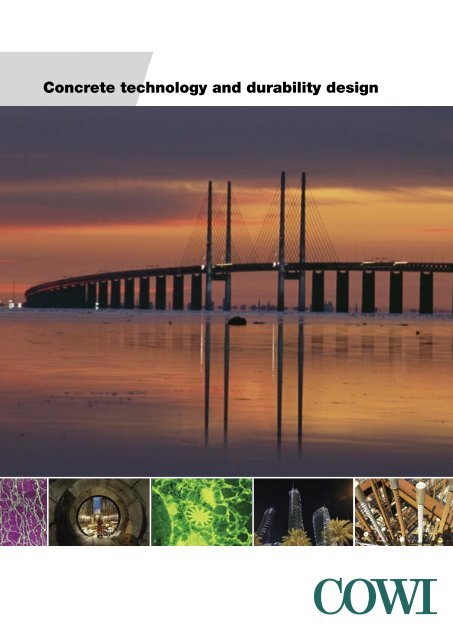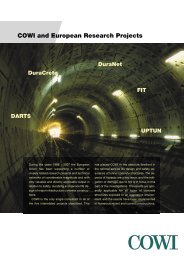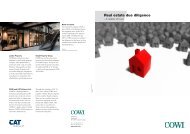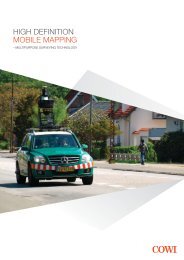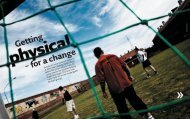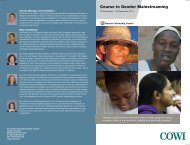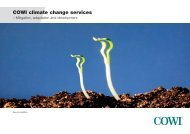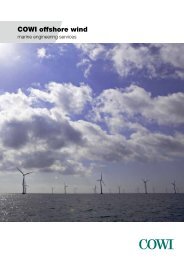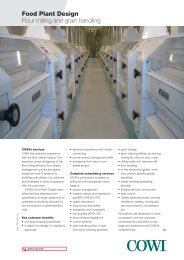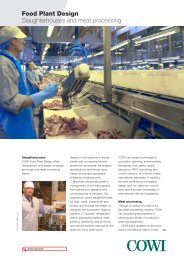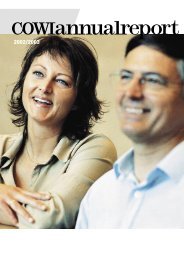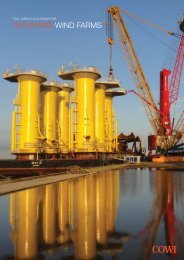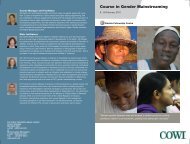Concrete technology and durability design - Cowi
Concrete technology and durability design - Cowi
Concrete technology and durability design - Cowi
You also want an ePaper? Increase the reach of your titles
YUMPU automatically turns print PDFs into web optimized ePapers that Google loves.
<strong>Concrete</strong> <strong>technology</strong> <strong>and</strong> <strong>durability</strong> <strong>design</strong>
COWI <strong>and</strong> concreteBeirut Seafront <strong>and</strong> Marinas, LebanonCOWI – the companyCOWI is internationally recognisedas a major consultant in several areasfrom energy <strong>and</strong> waste to economics,but in particular known forits leading position in major bridge,road, airport, marine structures <strong>and</strong>tunnel projects throughout theworld. <strong>Concrete</strong> is a key materialfor these modern structures <strong>and</strong>COWI has therefore created a strongconcrete <strong>design</strong> <strong>and</strong> research environmentwithin the company toprovide specialist services in thisarea.<strong>Concrete</strong> – the materialThe structural <strong>design</strong>, suitable specificationsfor the concrete <strong>and</strong> thereinforcement, the placing <strong>and</strong> theproper curing are all important parametersto achieve the desired results.COWI’s concrete <strong>technology</strong> expertisecovers st<strong>and</strong>ards <strong>and</strong> specificationsboth in Europe <strong>and</strong>internationally. Suitable specificationscan be prepared to ensure thatthe customer receives the concretesolution that is optimal for the intendedservice life requirements <strong>and</strong>the exposure conditions.COWI participates in R&D networks<strong>and</strong> projects with universities,government institutions as wellas private partners in several countries.COWI’s concrete technologists<strong>and</strong> <strong>design</strong>ers participate in national<strong>and</strong> international st<strong>and</strong>ard organisations,through CEN-groups, Danish<strong>and</strong> European st<strong>and</strong>ardisation work,FIB model codes, RILEM, etc. Theyare often invited speakers or keynote lecturers at international conferenceson concrete <strong>technology</strong> <strong>and</strong>this is reflected in the large numberof COWI publications <strong>and</strong> referencesin the concrete field.COWI seeks to include innovativeideas as part of large <strong>and</strong> smallprojects in order to create value fortheir customers through savings toprovide durable <strong>and</strong> sustainablesolutions.<strong>Concrete</strong> <strong>technology</strong> <strong>and</strong><strong>durability</strong> <strong>design</strong>• Durability <strong>and</strong> service life <strong>design</strong>• Specifications <strong>and</strong> constructionmonitoring• Materials <strong>technology</strong>• Special <strong>design</strong> solutionsSeeb International Airport, OmanGreen Heart Tunnel, The Netherl<strong>and</strong>sChedi Hotel, Oman
Sutong Bridge, China3
4Durability <strong>and</strong>service life <strong>design</strong>Villamar at the Harbour Development Project, BahrainCOWI’s <strong>durability</strong> <strong>design</strong> services• Assistance in defining the owner’sservice life requirement, e.g. endof <strong>design</strong> life, level of reliability <strong>and</strong>frequency of maintenance• Elaboration <strong>and</strong> evaluation ofdifferent <strong>durability</strong> <strong>design</strong> optionsincluding appropriate structuraldetailing• Assessment of macro <strong>and</strong> microexposure conditions• Modelling of deteriorationmechanisms for materials <strong>and</strong>environmental actions• Service life modelling <strong>and</strong> <strong>design</strong>using the DuraCrete approach• Development of appropriatespecifications for materials through<strong>durability</strong> modelling• Conversion of specificationsto concrete mix <strong>design</strong>s <strong>and</strong>compliance testing• Back analysis of service life uponcompletion of construction• Quality assurance programmes• Life cycle costing• The Birth CertificateProbabilistic service life <strong>design</strong>Nowadays, civil engineering structures,such as bridges, tunnels, marinestructures <strong>and</strong> other infrastructureprojects, are <strong>design</strong>ed for aservice life of 100, 120 or even 200years. This surpasses the assumed<strong>design</strong> service life of most codes <strong>and</strong>st<strong>and</strong>ards substantially.The operational approach to <strong>design</strong>for <strong>durability</strong> is to define <strong>durability</strong>as a service life requirement.In this way, the non-factual <strong>and</strong>rather subjective concept of ‘<strong>durability</strong>’is transformed into a factualrequirement of a number of yearsduring which the structure performssatisfactorily without unforeseenhigh costs for maintenance. In thisway, the time factor is introduced asa <strong>design</strong> parameter. Service life <strong>design</strong>based on these functional requirementsis carried out in a similarway to the load <strong>and</strong> resistance factor<strong>design</strong> concept used for structural<strong>design</strong>.COWI’s leading position within <strong>durability</strong><strong>design</strong> is based on morethan 40 years of worldwide experiencein <strong>design</strong>, operation <strong>and</strong> maintenanceof reinforced concrete structures.COWI, spearheading the internationaldevelopment of rational servicelife <strong>design</strong>s, provides a modernfully probabilistic <strong>design</strong> methodologyfor durable concrete structures,i.e. the DuraCrete approach. COWIimplements this state-of-the-art approachin new <strong>design</strong>s <strong>and</strong> in the reevaluationof existing structures. Ithas been adopted by national authorities<strong>and</strong> individual clients allover the world as well as by internationalassociations, e.g. fib.The DuraCrete approach can effectivelycombat chloride <strong>and</strong> carbonationinduced reinforcementcorrosion. All uncertainties regardingenvironmental exposure, materialproperties <strong>and</strong> deterioration aretaken into account.AssumptionsTerms of definitionsOther administrative provisionsPrinciples of service lifeDesign criteriaFull probabilisticapproachProbabilistic models:- Resistances- Load/exposure- GeometryPartial factor <strong>design</strong>Design values:- Characteristic values- Partial safety factors- Combination factorsLimit states Design equations Design provisions Design provisionsDesign/verificationsProject specification for material selection <strong>and</strong> executionMaintenance planInspection/monitoring planQuality plan for execution(optional)Deemed to satisfy <strong>design</strong>Exposure classesAvoidance ofdeteriorationExposure classesIn case of non-confirmity with the performance criteria, thestructure becomes either obsolete or subject to a re<strong>design</strong>Service life <strong>design</strong> flow chartafter fib: “Model Code forService Life Design”MaintenanceInspection of executionCondition control during service life
5Busan-Geoje Fixed Link, South KoreaLife cycle costingLife cycle cost optimisation, e.g.formulated as an optimisation of thenet present value of a structure, hasbecome an integral part of COWI’sservice life <strong>design</strong> philosophy. Withoutthis, a rational evaluation offuture costs in a comparable mannerto rate alternative solutions, preferablyas a life cycle costing (LCC),the service life <strong>design</strong> will not bepossible. This is mainly because anyserious savings in future maintenancecosts will not be adequatelyconsidered to compensate for anyincreased initial construction costs,although such future savings may bevery substantial. COWI’s LCC servicesinclude:• Recognition of potential savingsin whole-life costs through builtin<strong>durability</strong>, e.g. selective use ofstainless steel• Evaluation of life-cycle costing<strong>and</strong> cost optionsThe Birth CertificateA valuable means to increase theknowledge of the expected performance<strong>and</strong> service life is to establish abaseline study of the finally achievedquality of the in-situ structure. Thiscould conveniently be done <strong>and</strong> reportedas part of the h<strong>and</strong>ing-overof the structure from the contractorto the owner. Therefore, COWI hasestablished the concept of the BirthCertificate, which includes a firstforecast of the service life based onfactual data, e.g. the actual coverthicknesses <strong>and</strong> the actual chloridediffusion coefficients, from the existingstructure. At later inspectionsthis data can be updated <strong>and</strong> usedto revise the expected residual servicelife resulting in an ever-increasingaccuracy of the remaining servicelife forecast. This powerfuldecision tool provides the ownerwith valuable information on futuremaintenance <strong>and</strong> repair needs. Influence of concrete cover on service lifeGuidelines for service life <strong>design</strong>DuraCrete:General guidelines for<strong>durability</strong> <strong>design</strong> <strong>and</strong>re<strong>design</strong>fib:Model code forservice life <strong>design</strong>Financial Harbour, 53-storey tower, BahrainStonecutters Bridge, Hong Kong, China
6Specifications <strong>and</strong> construction monitoringThe Pearl Development Project, QatarQA at precasting yard, Busan-GeojeFixed Link, South KoreaQA at immersed tunnel site, Busan-Geoje Fixed Link, South KoreaSpecificationsCOWI has many years experience inassisting both clients <strong>and</strong> contractorsin the preparation <strong>and</strong>/or reviewof specifications for major internationalprojects, including immersed <strong>and</strong>bored tunnels, all types of bridges,marine structures, airports <strong>and</strong> infrastructureschemes all over theworld. Irrespective of the type ofcontract COWI can provide specialistassistance to fulfil particular needs.COWI’s expertise is based on athorough underst<strong>and</strong>ing of the relevantinternational st<strong>and</strong>ards complementedby an extensive knowledgeof concrete <strong>and</strong> materials <strong>technology</strong>in combination with experience in amultiplicity of construction techniques.Consequently, COWI hasthe ability to interpret any specialdem<strong>and</strong>s, be they structural, environmentalor financial, in order toprovide specific requirements forparticular parts of a project.Quality assurance <strong>and</strong>construction monitoringIn order for a concrete structure tofunction as foreseen by the <strong>design</strong>,the construction process must becontrolled by a suitably framedquality assurance (QA) scheme.COWI has the knowledge to establishsuitable QA schemes in linewith the preparation of project specifications.In addition, COWI hasexperienced concrete specialists,who can review/audit constructionmaterials, mix <strong>design</strong>s, functionalrequirements, method statements<strong>and</strong> inspection <strong>and</strong> test plans, etc.,against specified requirements <strong>and</strong>project objectives.Consequently, the same personnelhave the ability to assess the acceptabilityof non-conformances if <strong>and</strong>when they arise <strong>and</strong> the suitabilityof associated corrective actions, remedialworks, etc., to ensure thatthe project objectives are met.QA at segment factory, Hall<strong>and</strong>såsTunnel, Sweden
7Customised formwork, Hall<strong>and</strong>sås Tunnel, SwedenCooling pipes for control of heatdevelopment during curingArchitectural finishesArchitectural finishes is another areaof importance as the achievement ofan acceptable surface finish to theconcrete is often in conflict with the<strong>durability</strong> requirements of a structure.This is particularly importantwhere prestigious <strong>and</strong>/or innovativestructures are exposed to harsh environments,e.g. the Middle East.COWI has special experience <strong>and</strong>interest in this area <strong>and</strong> can adviceon appropriate solutions to achievethe overall architectural objectivesof the project.Architect’s model for underground station,Copenhagen Metro, DenmarkCuring <strong>technology</strong>In order to secure the long term <strong>durability</strong>of a concrete structure a wellthought-out curing programmeshould be specified <strong>and</strong> the curingproperly monitored during construction.COWI’s main areas of curing<strong>technology</strong> expertise include:• Control of early age cracking dueto thermal movements, earlyshrinkage, creep <strong>and</strong> settlements• Evaporation control to avoid thedamaging effects of drying outwhich can lead to cracking <strong>and</strong>reduction in surface quality• Hot weather concreting, particularlyrelevant to the Middle East <strong>and</strong>other high temperature environments• Cold weather concreting to ensureearly protection from damage dueto freezing conditions• Limitation of maximum temperatureto avoid the deterioration effect ofdelayed ettringite formation (DEF)Most of the above curing conditionsare interconnected <strong>and</strong> cannot beconsidered in isolation.COWI has experienced personnel<strong>and</strong> specialist tools, e.g. 2/3-D finiteelement method (FEM) programmesfor temperature <strong>and</strong> stress simulationto <strong>design</strong> appropriate integratedcuring systems <strong>and</strong>/or review proposedsystems against specified requirements.3-D FEM simulations of heatdevelopment during curing. Basedon R&D collaboration with IPL,DTU, Lyngby, Denmark
8Materials <strong>technology</strong>COWI’s concrete <strong>and</strong> materials specialistshave broad internationalexperience from almost every regionaround the world <strong>and</strong> from almostevery type of civil engineering structure.COWI’s concrete <strong>and</strong> materialsgroup has more than 40 years experiencein materials <strong>and</strong> concrete investigationmethods, <strong>durability</strong> <strong>and</strong><strong>technology</strong> <strong>and</strong> contribute regularlyto national <strong>and</strong> international conferences,books <strong>and</strong> magazines on concrete<strong>and</strong> reinforcement, from the<strong>design</strong> stage up to <strong>and</strong> including theas-built phase.Activities include all kinds of material<strong>and</strong> construction topics, rangingfrom petrography <strong>and</strong> scanningelectron microscopy at nanometrelevel to large scale tunnelling, bridge<strong>and</strong> pavement construction.COWI has an in-house, ISO 9001certified concrete laboratory specialisedin concrete investigations fromchemical analyses <strong>and</strong> petrographyto destructive as well as non-destructivemethods.With funding from the WorldBank <strong>and</strong> DANIDA, COWI has presentedinnovative solutions in roadconstruction with the use of alternativebinders <strong>and</strong>/or marginal aggregatesin road stabilisation. Besidesproviding passable roads all yearround in third world regions, suchsolutions are also environmentallyfriendly with regard to preservationof aggregate resources as well aslimiting CO 2 emissions.<strong>Concrete</strong> microstructureCOWI’s specialists have been involvedin many investigations concerningconcrete <strong>durability</strong> <strong>and</strong> deteriorationof various kinds ofconcrete structures worldwide; especiallywith several references fromthe Middle East known for its harshclimate.COWI’s materials <strong>and</strong> concrete specialistsare recognised in their separatefields as independent experts toperform investigations <strong>and</strong> evaluationsof new or deteriorated concrete<strong>and</strong> whenever a technical disputemay arise. This also includesexpert witness assistance in caseswhich may end up in court. Designtopics <strong>and</strong> expert knowledge onmaterials <strong>and</strong> st<strong>and</strong>ards from allover the world are also part ofCOWI’s knowledge base.Optical microscopyon thin sections<strong>Concrete</strong> block with severe cracking caused by DEF <strong>and</strong>testing of cores by thin section microscopy <strong>and</strong> residualexpansion measurements
9Deterioration mechanismsCOWI’s main fields of expertise inmaterials <strong>technology</strong> include evaluationof concrete concerning:• Surface attack• Chloride ingress <strong>and</strong> risk of corrosion• Surface carbonation• Detection of causes of cracking• Determination of concrete compositionincluding water-cement ratio,type <strong>and</strong> content of cement aswell as aggregate, use of air entrainment,addition of fly ash,blast furnace slag, silica fume, etc.• Sulphate <strong>and</strong> seawater attack,delayed ettringite formation (DEF)<strong>and</strong> thaumasite formation• Soft water leaching, carbonic acid<strong>and</strong> aggressive CO 2 attack• Alkali-silica reactions (ASR) <strong>and</strong>residual reactivity <strong>and</strong> expansionpotential. Experience with localaggregate types <strong>and</strong> test methods• Freeze-thaw <strong>durability</strong>, evaluationof quality of entrained air voidsystemsSuch evaluations, alone or combinedwith other advanced investigations,can solve almost any case of prematureconcrete deterioration. Investigationsof concrete exposed to chloridescan include determination ofchloride profiles <strong>and</strong> determinationof the chloride diffusion coefficientto quantify the future risk of reinforcementcorrosion.Modelling of the residual servicelifetime by the DuraCrete approachor other models is based on reliableresults obtained from advanced laboratoryinvestigations.Thin section microscopy showing alkali-silicareactive aggregate <strong>and</strong> gel in air voidInnovative, environmentally friendly <strong>and</strong>low-cost road construction methods usingblast furnace slag or local pozzolans forstabilisation of secondary or marginalaggregate resources, TanzaniaScanning electron microscopyshowing ettringite in paste, cracks<strong>and</strong> voids of concrete exposed tosea water
10Special <strong>design</strong>solutionsCOWI’s <strong>durability</strong> <strong>and</strong> concretespecialists have a broad internationalexperience in tailored, specialconcrete <strong>and</strong> reinforcement <strong>design</strong>solutions.Selected special <strong>design</strong> solutionsoffered by COWI include, but arenot limited to the following:• High performance concrete• Self-compacting concrete• Steel fibre reinforced concrete• Polypropylene fibre concrete• Green concrete• Membranes• Diaphragm walls <strong>and</strong> secant piles• Corrosion resistant reinforcementHigh performance concreteThe continuous dem<strong>and</strong> for increasedstrength <strong>and</strong> improved <strong>durability</strong>of concrete structures hasled to the development of HPC. Thisdevelopment had three main objectives:• Protect the reinforcement againstcorrosion• Resist deterioration of the concreteitself• Provide adequate high strength tofulfil the structural requirementsHPCs for normal type structuresusually have a high cementitiousbinder content, a low water-cementratio <strong>and</strong> higher contents of plasticiser<strong>and</strong> superplasticiser. Such concretecan be used for bridges, tunnels,marine works, offshorestructures <strong>and</strong> high rise buildings,where the strength requirementsusually remain within a range of 50-80 MPa. A drawback of HPC is thatthe more refined the concrete mixesbecome, the higher is the sensitivityin relation to the actual h<strong>and</strong>lingduring execution.SFRC foundations <strong>and</strong> slab for high-bay warehouse,Carlsberg Brewery, Fredericia, DenmarkHPC sets high dem<strong>and</strong>s on competence<strong>and</strong> experience; competence<strong>and</strong> experience that COWI can offer.Self-compacting concreteA concrete mix, where the placing<strong>and</strong> compaction has minimal dependenceon the available workmanshipon site, improves the truequality of the concrete in the finalstructure. This has been the maindriving force in recent years’ developmentof self-compacting concrete(SCC). With the aid of a range ofchemical admixtures <strong>and</strong> optimalgrading of the aggregates, concretewith a low water-cement ratio canbe made to flow through complicatedform geometry <strong>and</strong> around complexreinforcement without segregation.The form can be filled <strong>and</strong> auniform compaction without honeycombscan be achieved, also in thecover zone of the concrete. SCCexerts an increased pressure (attimes close to the hydrostatic pressure)on the formwork.COWI’s concrete specialists provideexpert knowledge on both mix<strong>design</strong> <strong>and</strong> execution includingformwork <strong>design</strong> for SCC.Constituents of a typical HPC mix,“cocktail concrete”Compressivestrength test ofHPC. Courtesyof BAM, Berlin,GermanySlump flow test with 4C-Rheometer todetermine the yield stress <strong>and</strong> plasticviscosity of SCC. Courtesy of DTI,Taastrup, Denmark
11Steel fibre reinforced concreteFor many applications steel fibrereinforced concrete (SFRC) is a verysuitable solution for structural members,which are not highly loaded inflexure or tension. Besides advantagesin terms of construction <strong>and</strong>cost, SFRC grants structural benefits<strong>and</strong> superior <strong>durability</strong> propertiescompared to conventional reinforcedconcrete. The capacity of thefibres to reduce crack width <strong>and</strong>deflection is often more importantthan the increase in tensile strengthof the concrete. Furthermore, theaddition of fibres enables bearingcapacities after cracking <strong>and</strong> allowsstress redistribution, which makesthe otherwise quasi-brittle behaviourof the concrete more ductile.COWI has manifold experience<strong>and</strong> expert knowledge in all phasesof the <strong>design</strong> <strong>and</strong> the execution ofSFRC structures.Polypropylene fibre concreteThe provision of an adequate levelof fire protection is particularly importantfor tunnels as has been witnessedby the Great Belt <strong>and</strong> ChannelTunnel experience, but it canalso be relevant to other structureswhere the evacuation of personnel<strong>and</strong> emergency services should beprotected.With regard to concrete structuresthe addition of a relatively smallamount of polypropylene fibres(PPF) to the concrete during themixing process can provide considerableimprovement in the fire resistanceof the finished structure. Arecent innovation has been to addPPF to shotcrete to improve the fireresistance of existing structures <strong>and</strong>unstable rock formations.COWI has considerable experiencein this area to provide assistancewith the following:• <strong>Concrete</strong> <strong>and</strong> shotcrete mix <strong>design</strong>s• Fixing systems for shotcrete• Fire testing• Acceptance criteriaGreen concreteGreen concrete is a synonym forresource-saving concrete. Use ofgreen concrete reduces the environmentalimpact of concrete structureswith regard to energy consumption,waste water <strong>and</strong> CO2 emissions.Green concrete can be less expensiveto produce, because waste productscan be used as a partial substitutefor cement, l<strong>and</strong>fill taxes can beavoided <strong>and</strong> the energy consumptionin production can be lowered.COWI’s concrete specialists havebeen involved in related R&Dprojects <strong>and</strong> are experienced in specifyinggreen concrete.Tunnel fire test. Courtesy of SINTEF,Trondheim, Norway<strong>Concrete</strong> slab without PPFs during firetest, Hall<strong>and</strong>sås Tunnel, SwedenFE simulation of principal stressdistribution from concentratedloading of TBM push rams forstructural <strong>design</strong> of SFRC liningsegments, District HeatingTunnel, Copenhagen, DenmarkSFRC lining segments, District HeatingTunnel, Copenhagen, Denmark
12Special <strong>design</strong> solutionsWaterproofing membrane installed inbored tunnel, Hall<strong>and</strong>sås Tunnel, SwedenSelective use of stainless steel reinforcement,Stonecutters Bridge, Hong Kong, ChinaSelective use of stainless steel reinforcement,Sheikh Zayed Bridge, Abu DhabiPhotomontage: HPRMembranesThe application of membranes forconcrete structures can be twofold:either to achieve a watertight concretestructure or to act as a protectivebarrier in case of concrete attack,e.g. high sulphate concentrationsin soil/groundwater.COWI has specialist experience<strong>and</strong> can support clients <strong>and</strong> contractorswith selecting the most appropriatemembrane type depending onthe aggressivity of the environment,the geometric conditions of thestructure <strong>and</strong> the construction procedure.Diaphragm walls <strong>and</strong> secantpilesHistorically, diaphragm walls <strong>and</strong>secant piles have been used withsuccess in relatively benign environments.However, in more hostile oraggressive environments, e.g. in theMiddle East, <strong>and</strong> with extendedservice life expectancy, special measuresare necessary to secure the required<strong>durability</strong> of the structure.COWI has specialist experience inthis area <strong>and</strong> can support clients<strong>and</strong> contractors by providing innovative<strong>durability</strong> <strong>design</strong> solutions, asspecial reinforcement solutions <strong>and</strong>/or concrete mix-<strong>design</strong> requirementsto mitigate the effects of chlorideinduced reinforcement corrosion.Corrosion resistantreinforcementThe implementation of corrosionresistant steel reinforcement is thesimplest <strong>and</strong> most effective methodto eliminate the risk of reinforcementcorrosion. This method doesnot only solve the corrosion problemin an infallible way even in themost corrosive chloride environments,but it also leaves the siteactivities nearly unchanged. Theselective use of stainless steel reinforcementin zones exposed to highchloride concentrations is a highlyreliable solution. This solution ensuresvery long problem-free servicelife in that part of the structure, providedthe concrete itself is made sufficientlyresistant to avoid othertypes of deterioration. Of particularimportance is the often overlookedfact, that SSR can be coupled withcarbon steel reinforcement withoutcausing galvanic corrosion. Anotherbenefit is the added value, whichfollows from the possibility of acceptingthe use of locally availablematerials even with chloride contamination<strong>and</strong> the possible lack ofspecial qualifications of the localwork force.COWI has expert knowledge inspecifying appropriate reinforcementsolutions to attain the requiredservice life in all possible environments.COWI’s <strong>durability</strong> specialists canalso offer services concerning theassessment of alternative corrosioncountermeasures for concrete reinforcement<strong>and</strong> for the evaluation ofcorrosion protection of exposedstructural steel. This is supported bya continuous cooperation with universities<strong>and</strong> COWI’s involvement invarious related ongoing <strong>and</strong> futureR&D projects.Testing of reinforcementcorrosion countermeasures
13Tunnel shaft with secant piles <strong>and</strong>waterproofing membrane, DistrictHeating Tunnel, Copenhagen, DenmarkPhoto: Henrik Pyndt Sørensen
Selected references15Villamar at the Harbour DevelopmentProject, Bahrain. Durability <strong>design</strong> forservice life of 50 years, 2007Hellmuth, Obata + Kassabaum (HOK)Offshore wind turbines, Sweden.Durability <strong>design</strong> of foundations forservice life of 25 years, 2005Metro Circle Line, Copenhagen, Denmark.Durability <strong>design</strong> for service life of 100years, 2007-2018Photo: Rene Str<strong>and</strong>bygaardLusail Development Project, Qatar.Durability <strong>design</strong> for service life of 50years, 2007District Heating Tunnel, Copenhagen,Denmark. Structural <strong>design</strong> of SFRC liningsegments <strong>and</strong> <strong>durability</strong> <strong>design</strong> of shafts forservice life of 100 years, 2004Photo: Henrik Pyndt SørensenNational Library, Qatar. Reassessment ofpiles <strong>and</strong> foundation, 2005-2006Al Reem Isl<strong>and</strong> Development Project, AbuDhabi. Durability <strong>design</strong> of foundationsfor service life of 50 years, 2007Busan-Geoje Fixed Link, South Korea.Durability <strong>design</strong> of bridge <strong>and</strong> immersedtunnel for service life of 100 years, 2005Messina Strait Bridge, Italy. Tender<strong>durability</strong> <strong>design</strong> for service life of 200years, 2005Great Belt Link, Denmark. Service lifeupdate from 100 to 150 years based onactual chloride profiles, 2001Photo: Jan Kofoed Winther Courtesy of ATI Impregilo S.p.AFinancial Harbour Development Project,Bahrain. Durability assessment includingBirth Certificate, 2006Sitra Bridges, Bahrain. Durability study of<strong>design</strong> alternatives for replacement ofbridges, 2004Sutong Bridge, China. Durability <strong>design</strong>for service life of 100 years, 2003Stonecutters Bridge, Hong Kong, China.Audit of <strong>durability</strong> <strong>design</strong> service life of100 years, 2005Photom.: Ove Arup & Partners
COWI officesInternational Projectswww.cowi.comCOWI is a leading northern Europeanconsulting group. We providestate-of-the-art services within thefields of engineering, environmentalscience <strong>and</strong> economics with dueconsideration for the environment<strong>and</strong> society. COWI is a leader withinits fields because COWI’s 3500employees are leaders within theirs.Dr.-Ing.Carola EdvardsenSection Manager<strong>Concrete</strong> Technology<strong>and</strong> Durability Design+45 4597 2813cle@cowi.comHeadquarters:COWI A/SParallelvej 2DK-2800 Kongens LyngbyDenmarkTel.: +45 45 97 22 11Fax: +45 45 97 22 12E-mail: cowi@cowi.comInternet: www.cowi.comPhoto front page:Daniel Andersson <strong>and</strong>Henrik Pyndt Sørensen021-1700-031e-07aPrintet in Denmark by Kailow


